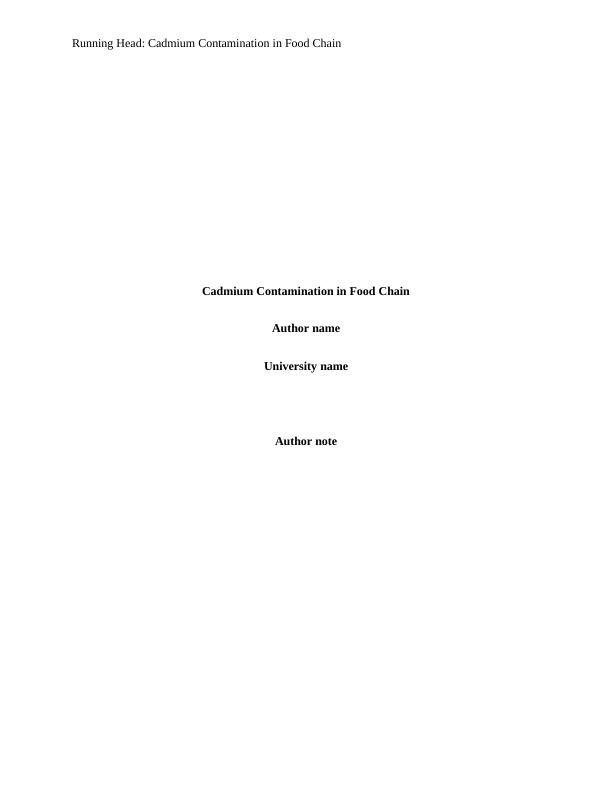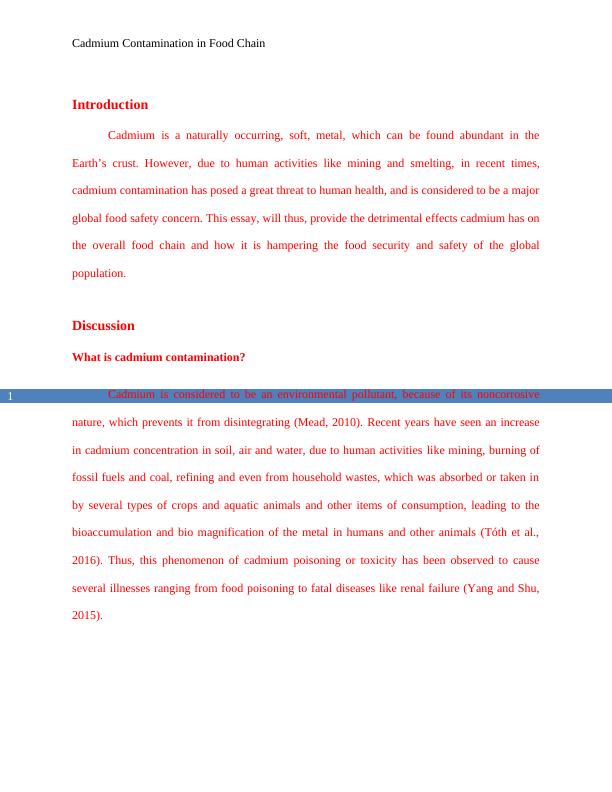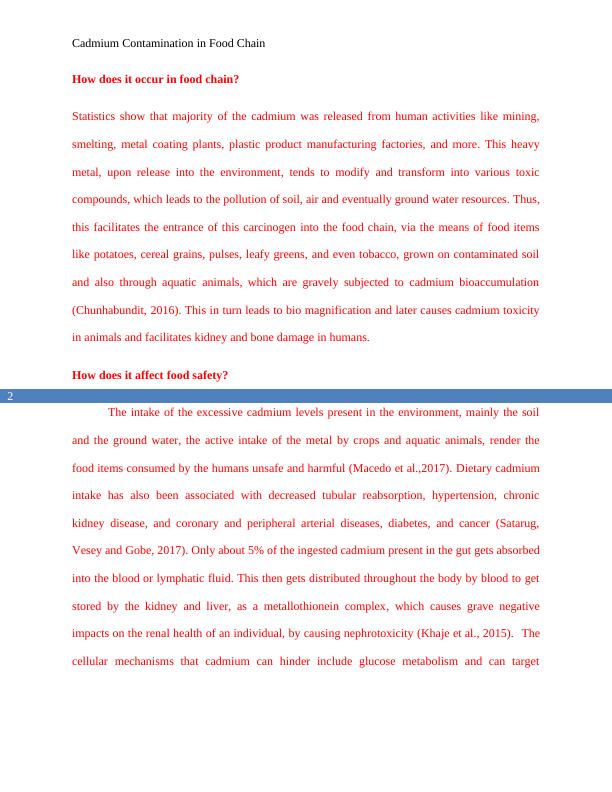Cadmium Contamination in Food Chain
Added on 2022-10-12
12 Pages2928 Words235 Views
Running Head: Cadmium Contamination in Food Chain
Cadmium Contamination in Food Chain
Author name
University name
Author note
Cadmium Contamination in Food Chain
Author name
University name
Author note

1
Cadmium Contamination in Food Chain
Introduction
Cadmium is a naturally occurring, soft, metal, which can be found abundant in the
Earth’s crust. However, due to human activities like mining and smelting, in recent times,
cadmium contamination has posed a great threat to human health, and is considered to be a major
global food safety concern. This essay, will thus, provide the detrimental effects cadmium has on
the overall food chain and how it is hampering the food security and safety of the global
population.
Discussion
What is cadmium contamination?
Cadmium is considered to be an environmental pollutant, because of its noncorrosive
nature, which prevents it from disintegrating (Mead, 2010). Recent years have seen an increase
in cadmium concentration in soil, air and water, due to human activities like mining, burning of
fossil fuels and coal, refining and even from household wastes, which was absorbed or taken in
by several types of crops and aquatic animals and other items of consumption, leading to the
bioaccumulation and bio magnification of the metal in humans and other animals (Tóth et al.,
2016). Thus, this phenomenon of cadmium poisoning or toxicity has been observed to cause
several illnesses ranging from food poisoning to fatal diseases like renal failure (Yang and Shu,
2015).
Cadmium Contamination in Food Chain
Introduction
Cadmium is a naturally occurring, soft, metal, which can be found abundant in the
Earth’s crust. However, due to human activities like mining and smelting, in recent times,
cadmium contamination has posed a great threat to human health, and is considered to be a major
global food safety concern. This essay, will thus, provide the detrimental effects cadmium has on
the overall food chain and how it is hampering the food security and safety of the global
population.
Discussion
What is cadmium contamination?
Cadmium is considered to be an environmental pollutant, because of its noncorrosive
nature, which prevents it from disintegrating (Mead, 2010). Recent years have seen an increase
in cadmium concentration in soil, air and water, due to human activities like mining, burning of
fossil fuels and coal, refining and even from household wastes, which was absorbed or taken in
by several types of crops and aquatic animals and other items of consumption, leading to the
bioaccumulation and bio magnification of the metal in humans and other animals (Tóth et al.,
2016). Thus, this phenomenon of cadmium poisoning or toxicity has been observed to cause
several illnesses ranging from food poisoning to fatal diseases like renal failure (Yang and Shu,
2015).

2
Cadmium Contamination in Food Chain
How does it occur in food chain?
Statistics show that majority of the cadmium was released from human activities like mining,
smelting, metal coating plants, plastic product manufacturing factories, and more. This heavy
metal, upon release into the environment, tends to modify and transform into various toxic
compounds, which leads to the pollution of soil, air and eventually ground water resources. Thus,
this facilitates the entrance of this carcinogen into the food chain, via the means of food items
like potatoes, cereal grains, pulses, leafy greens, and even tobacco, grown on contaminated soil
and also through aquatic animals, which are gravely subjected to cadmium bioaccumulation
(Chunhabundit, 2016). This in turn leads to bio magnification and later causes cadmium toxicity
in animals and facilitates kidney and bone damage in humans.
How does it affect food safety?
The intake of the excessive cadmium levels present in the environment, mainly the soil
and the ground water, the active intake of the metal by crops and aquatic animals, render the
food items consumed by the humans unsafe and harmful (Macedo et al.,2017). Dietary cadmium
intake has also been associated with decreased tubular reabsorption, hypertension, chronic
kidney disease, and coronary and peripheral arterial diseases, diabetes, and cancer (Satarug,
Vesey and Gobe, 2017). Only about 5% of the ingested cadmium present in the gut gets absorbed
into the blood or lymphatic fluid. This then gets distributed throughout the body by blood to get
stored by the kidney and liver, as a metallothionein complex, which causes grave negative
impacts on the renal health of an individual, by causing nephrotoxicity (Khaje et al., 2015). The
cellular mechanisms that cadmium can hinder include glucose metabolism and can target
Cadmium Contamination in Food Chain
How does it occur in food chain?
Statistics show that majority of the cadmium was released from human activities like mining,
smelting, metal coating plants, plastic product manufacturing factories, and more. This heavy
metal, upon release into the environment, tends to modify and transform into various toxic
compounds, which leads to the pollution of soil, air and eventually ground water resources. Thus,
this facilitates the entrance of this carcinogen into the food chain, via the means of food items
like potatoes, cereal grains, pulses, leafy greens, and even tobacco, grown on contaminated soil
and also through aquatic animals, which are gravely subjected to cadmium bioaccumulation
(Chunhabundit, 2016). This in turn leads to bio magnification and later causes cadmium toxicity
in animals and facilitates kidney and bone damage in humans.
How does it affect food safety?
The intake of the excessive cadmium levels present in the environment, mainly the soil
and the ground water, the active intake of the metal by crops and aquatic animals, render the
food items consumed by the humans unsafe and harmful (Macedo et al.,2017). Dietary cadmium
intake has also been associated with decreased tubular reabsorption, hypertension, chronic
kidney disease, and coronary and peripheral arterial diseases, diabetes, and cancer (Satarug,
Vesey and Gobe, 2017). Only about 5% of the ingested cadmium present in the gut gets absorbed
into the blood or lymphatic fluid. This then gets distributed throughout the body by blood to get
stored by the kidney and liver, as a metallothionein complex, which causes grave negative
impacts on the renal health of an individual, by causing nephrotoxicity (Khaje et al., 2015). The
cellular mechanisms that cadmium can hinder include glucose metabolism and can target

3
Cadmium Contamination in Food Chain
different organs like pancreases, adrenal gland and liver. It can affect the pancreatic cells by
limiting the secretion of insulin.
How does it affect food security?
In recent times, cadmium contamination has posed a great threat to human health, and is
considered to be a major global food security concern (Wang et al., 2019). Cadmium’s biological
half-life in the body is estimated to be 30 years, which is due to the body’s inability to effectively
eliminate the metal that can result in genetic mutations which get transferred to the future
generations causing a variety of genetic disorders (Rapisarda, 2018). In the year 2009, the
Contaminants in the Food Chain of European Food Safety Authority (EFSA) panel suggested
that the provisional tolerable weekly intake of cadmium should be lowered to a weekly intake
(TWI) of 2.5 μg/kg bw. To prevent health risk of cadmium contamination the monthly intake
needs to be below 25 μg/kg bw
Natural contamination in some types of foods
Cadmium being a naturally occurring metal, which can easily contaminate ground water,
is vastly prevalent in different vegetables and fruits, and even in different fishes, which are
consumed by humans (Oskarsson et al., 2004). The percentage of cadmium content on food
groups like various roots and tubers, pulses, fruits, and cereals, ranging from 6% - 31%
respectively. Due to the phenomenon off bioaccumulation, it has been seen to have accumulated
in aquatic organisms like crustaceans (shrimps, crabs, lobsters), molluscs (oysters, octopuses,
snails), and other fishes (Wang and Rainbow, 2008). Leafy greens like broccoli, spinach and
lettuce along with leaves of addictive substances like tobacco are also subjected to an increase in
the accumulation and magnification of cadmium content in them. Even though these occur
Cadmium Contamination in Food Chain
different organs like pancreases, adrenal gland and liver. It can affect the pancreatic cells by
limiting the secretion of insulin.
How does it affect food security?
In recent times, cadmium contamination has posed a great threat to human health, and is
considered to be a major global food security concern (Wang et al., 2019). Cadmium’s biological
half-life in the body is estimated to be 30 years, which is due to the body’s inability to effectively
eliminate the metal that can result in genetic mutations which get transferred to the future
generations causing a variety of genetic disorders (Rapisarda, 2018). In the year 2009, the
Contaminants in the Food Chain of European Food Safety Authority (EFSA) panel suggested
that the provisional tolerable weekly intake of cadmium should be lowered to a weekly intake
(TWI) of 2.5 μg/kg bw. To prevent health risk of cadmium contamination the monthly intake
needs to be below 25 μg/kg bw
Natural contamination in some types of foods
Cadmium being a naturally occurring metal, which can easily contaminate ground water,
is vastly prevalent in different vegetables and fruits, and even in different fishes, which are
consumed by humans (Oskarsson et al., 2004). The percentage of cadmium content on food
groups like various roots and tubers, pulses, fruits, and cereals, ranging from 6% - 31%
respectively. Due to the phenomenon off bioaccumulation, it has been seen to have accumulated
in aquatic organisms like crustaceans (shrimps, crabs, lobsters), molluscs (oysters, octopuses,
snails), and other fishes (Wang and Rainbow, 2008). Leafy greens like broccoli, spinach and
lettuce along with leaves of addictive substances like tobacco are also subjected to an increase in
the accumulation and magnification of cadmium content in them. Even though these occur

End of preview
Want to access all the pages? Upload your documents or become a member.
Related Documents
Genetic Modified Microorganism for Bioremediationlg...
|19
|6311
|97
Cyanide Toxicity: Causes, Effects and Preventionlg...
|9
|2137
|351
